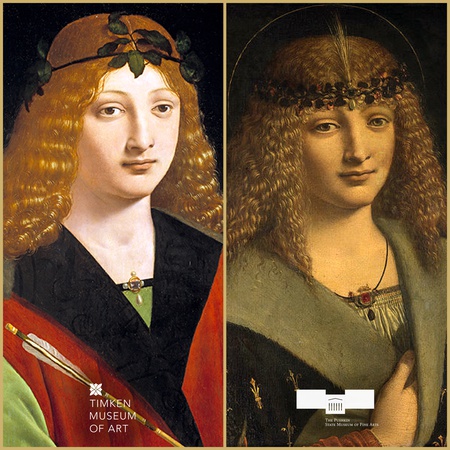Work of the Week #4
The small painting known as Portrait of a Youth with an Arrow by Giovanni Antonio Boltraffio (1467-1516) is noteworthy for its celebrated associations. First, and perhaps foremost, Boltraffio is best remembered for being a pupil of Leonardo da Vinci. Boltraffio belonged to a wealthy Milanese family and is mentioned in Giorgio Vasari’s biographical account of Leonardo’s life. Leonardo also mentions him by name in his notebooks. Furthermore, the soft features and serene expression of the young man in the Timken panel are reminiscent of Leonardo’s signature style. Boltraffio’s art historical reputation is modest by comparison to Leonardo’s, however. That fact partly accounts for a second association. The Timken’s picture was once owned by the Seventh Earl of Elgin, Thomas Bruce. Today, Lord Elgin is remembered mostly for his act of removing the marble decorations from the Parthenon in Athens in 1801. Within five years of orchestrating that controversial removal, Lord Elgin purchased Portrait of a Youth with an Arrow in Paris. At the time, he believed the painting was by Leonardo’s hand.
Since then, Portrait of a Youth with an Arrow has been studied by scholars, and included in exhibitions of Leonardo’s oeuvre, but always as the work of a follower. Students of Italian art history are increasingly interested in the “circle” surrounding Leonardo. The consensus that the Timken’s picture ought to be given to Boltraffio is less discouraging today, therefore, than it would have been to Lord Elgin, two centuries ago. We can further surmise that the identification of this painting as a “portrait” is a misnomer. Around the time of its purchase by the Putnam Foundation, in 1964, still another association was put forward: this might be a portrait of the Milanese poet, Girolamo Casio. But the Timken’s painting—while it prominently includes some attributes of the God of poetry, Apollo—doesn’t resemble any of the surviving depictions of Casio, including one painted by Boltraffio (1495, Pinacoteca di Brera, Milan). In fact, the work relates more closely to idealized subjects by the artist: a silverpoint drawing of Bacchus in the Galleria dell’ Accademia of Venice shows the same type of fair-haired young man with a nearly identical laurel wreath, and a depiction of Saint Sebastian at the Pushkin Museum in Moscow bears an even stronger resemblance to the face we encounter in San Diego.
While the Pushkin’s Portrait of a Boy as St. Sebastian (late 1490s) is far more finished than our panel, the two works have roughly the same dimensions and their poses are fundamentally the same. Like the Timken’s picture, the Pushkin’s Boltraffio once bore a hopeful attribution to Leonardo. It seems possible that both paintings could have served as preparatory studies for a large altarpiece showing Virgin and Child and Saints John the Baptist and Sebastian (c. 1500) now at the Louvre. The arrow held in the young man’s right hand further reinforces a connection between these representations. Sebastian was an early Christian martyr who Diocletian sentenced to death for his religious beliefs. Although Sebastian’s body was pierced multiple times by arrows, the execution miraculously failed. Could it be that Boltraffio is suggesting saintly triumph through his casual presentation of the arrow’s downturned shaft, the immaculate body, and the eternally calm countenance of this figure? We may never know for sure. Virtually from the start, uncertainty has surrounded this radiant picture.
